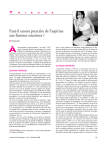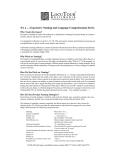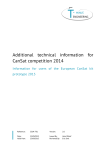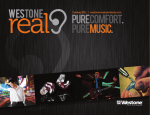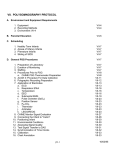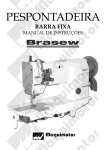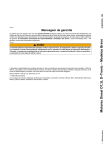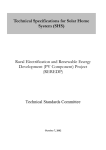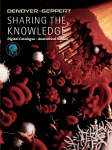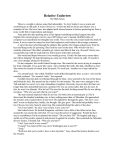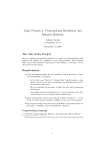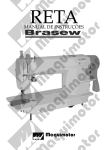Download use of evidence and instrumentation in the treatment of dysphagia
Transcript
4/13/2015 ISHA 2015 1 USE OF EVIDENCE AND INSTRUMENTATION IN THE TREATMENT OF DYSPHAGIA ISHA 2015 2 Disclosures • All of the speakers on the panel received an honorarium from ISHA for this talk Dee Dee Hammond MA, CCC-SLP, University Hospital Jessica Huber PhD, CCC-SLP, Purdue University Michele Parrish, MA, CCC-SLP, ENT Associates Dawn Wetzel MAT, CCC-SLP, Purdue University ISHA 2015 3 GOALS ISHA 2015 4 CONTENT • Name appropriate evidence-based exercise(s) given disordered physiology. Exercises Instrumentation • Provide examples of instrumentation to facilitate learning • Lingual Strengthening • IOPI/Swallow Strong of specific exercises. • Identify the instrumentation that is best suited to target specific physiologic deficits • Mendelsohn • sEMG • Super-Supraglottic • EMST/IMST • Effortful Swallow • Endoscopy • Shaker • Chin Tuck Against Resistance ISHA 2015 5 Rehabilitating the Swallow • Specificity ISHA 2015 6 Rehabilitating the Swallow • Intensity: • The exercise task should correspond with the • Percent maximum performance desired outcome • Strength training may work best when paired with task specific practice • Number of repetitions (power/pressure) • Frequency of practice • Duration of training over time • Overload • Mechanical • Feedback • Resistive • Accountability 1 4/13/2015 ISHA 2015 7 ISHA 2015 Rehabilitating the Swallow Interpretation of Video • Transference • Identify primary physiologic deficits 8 • Cross training and non-specific strength • Plan of Care training • What treatment has evidence to support its use • What instrumentation/feedback could facilitate learning of the treatment technique ISHA 2015 9 EVIDENCE AND INSTRUMENTATION LINGUAL STRENGTHENING, SHAKER AND CHIN TUCK AGAINST RESISTANCE ISHA 2015 10 ISHA 2015 12 SwallowSTRONG (Swallow Solutions, LLC) Dee Dee Hammond, M.A. CCC-SLP IU Health, University Hospital Indianapolis, IN [email protected] ISHA 2015 11 • 8 weeks of Isometric Progressive Swallow STRONG Program • Swallow STRengthening OropharyNgeal Gustatory (Swallow STRONG) program • Project Developers: Jo Anne Robbins, Ph.D, Nicole Pulia, Ph.D, Nasia Safdar M.D, Ph.D, and Jacqueline Hind, M.S. Resistance Oropharyngeal (I-PRO) therapy using the Madison Oral Strengthening Therapeutic (MOST) device (newer version: SwallowSTRONG by Swallow Solutions) • Followed by a simple long-term oropharyngeal strength maintenance program • Grant received by William S.Middleton Memorial Veterans Hospital in Madison, WI • Intensive oropharyngeal strengthening program designed to decrease health-related complications in veterans with dysphagia • Main goal: Improve swallowing and eating in veterans with dysphagia by providing strength training and biofeedback. 2 4/13/2015 ISHA 2015 13 ISHA 2015 14 Strengthening Protocol • I-PRO therapy with SwallowSTRONG • Involves active application of pressure by the tongue • • • Pressure is measured, by sensors, at four different locations of the tongue Sensor locations remain the same given the custommolded mouthpiece Electronic interface shows patient performance and calculates therapy targets. (Swallow Solutions) ISHA 2015 15 • SwallowSTRONG software provides knowledge of performance and results for both the patient and clinician. • Provides information regarding accuracy of movement and overall performance. Positive feedback encourages increased motivation • Progressive resistance training can increase strength and structural volume thus decreasing penetration, decreasing oropharyngeal residue and improving quality of life • Cost: Device and one mouthpiece: $3,995.00 (PNA ~$17,000) ISHA 2015 against stable resistance in the mouth (targets anterior, posterior, left, right, middle and whole tongue) • PROTOCOL: 10 lingual presses per sensor 3 times a day 3 days a week 8 weeks 17 Iowa Oral Performance Instrument System consists of carrying case, 1 connecting tube, 10 tongue bulbs and user manual. (IOPI Medical, LLC, ~$1100.00) ISHA 2015 16 Swallow STRONG Clinical Demonstration Project • Results from first 40 patients enrolled were presented • • • • • at DRS conference in Nashville, TN, by Nicole Pulia, Ph.D. Penetration-Aspiration Scale decreased for thin liquids Isometric pressures increased at front and back sensors Quality of life subscale scores improved as well as Functional Oral Intake Scale Several patients progressed from feeding tube dependency to full oral intake Number of pneumonia diagnoses decreased by 88% and hospital admissions decreased by 79% ISHA 2015 18 • Single air-filled plastic bulb attaches to a hand-held pressure transducer that measures pressure generated when the tongue is pressed against the hard palate • Objectively measures tongue and lip strength and endurance • PEAK function allows measurement of maximum pressure • LIGHTS function provides biofeedback for exercise and endurance • TIMER function allows measurement of time (helpful for endurance) 3 4/13/2015 ISHA 2015 19 ISHA 2015 20 Tongue Depressors as an Alternative • Typical Training Protocol • Elevation at 50% Pmax (max • In a study by Cathy Lazarus, et.al in 2003, three groups (all healthy adults between 20-29 years) were targeted. pressure) • 3 sets • 10 reps 3 times a day • Total 8 weeks • Squeeze bulb until top green light is on • Group 1: No exercise • Group 2: Use of tongue depressors for lingual strength • Group 3 Use of the IOPI for lingual strength Group 2 and 3: Exercised 5 days/week for one month (10 reps 5x day) targeting tongue lateralization, propulsion and elevation (Lazarus et. al, Folia Phoniatrica Logopaedica 55(4), 199-2005) ISHA 2015 21 After 4 weeks, results revealed significantly greater change in maximum tongue strength with both exercise groups No statistical difference was found between the exercise group using tongue depressors or the group using the IOPI ISHA 2015 22 So, what if my clinic has no money??? • Use your thumb! (Anterior tongue press) • Place the thumb just behind the top teeth and press the anterior tongue against the thumb • Pretend to say “k” (Posterior tongue press) • Place the thumb against the hard palate where tongue meets the hard palate for the “k” sound ISHA 2015 24 • Sustained Head-Lifts (Do this first) The Shaker Exercise • Created by Dr. Reza Shaker, gastroenterologist at the Medical College of Wisconsin. • Designed to treat pharyngeal dysphagia involving incomplete relaxation of the upper esophageal sphincter • Targets strengthening the suprahyoid muscles, thyrohyoid, mylohyoid, geniohyoid, and anterior belly of the digastric, as these muscles contribute to the upward and forward movement of the larynx and hyoid bone which results in relaxation of the UES (Shaker, et al. Am J Physiol 1997: 272) • Lie flat on your back with no pillow under your head. • Keep your shoulders flat against the bed or floor. • Lift your head only and look at your feet (chin tuck). • Work up to 60 seconds • Release and rest for one minute, repeat x2 • Complete 3 reps, 3 times a day 4 4/13/2015 ISHA 2015 25 ISHA 2015 26 • Exercise was found to increase the duration and width • Repetitive Head-Lifting: of the UES in the normal elderly population • Lie flat on your back. • Repetitively lift your head and look at • Shaker et al. in 2002, noted significant change in your feet. • Let your head go back down (slower • Shaker et al 1997, Easterling et al, in 2005, and speed=greater strength) functional swallow measures Logemann et al. in 2009, noted improved laryngeal elevation and UES dilation • Repeat this 30 times. • Rest for one minute. • Logemann et al in 2009, noted significantly less • Repeat two more times (90 total “sit- postswallow aspiration after 6 weeks of using Shaker exercise in tube fed population with severe oropharyngeal dysphagia due to abnormal UES opening ups” for your neck) • Do this exercise 3 x day for 6 weeks ISHA 2015 27 ISHA 2015 28 Chin Tuck Against Resistance Problems with Compliance • Elderly may need structured and gradually progressive program to achieve goals • Isometric exercises (sustained head lifts) were found to be harder than isokinetic exercises and therefore goals achieved less often • Muscle discomfort and time constraints were also reported • Head lifts were found to be too demanding for patients with chronic conditions • Resistance for Shaker: lifting head against gravity • Enhances Suprahyoid Muscle Activity (opening UES) using a Shaker-like exercise • Used for patients with dysphagia due to upper esophageal sphincter dysfunction • Aim of study: determine if the CTAR exercise was as effective as the Shaker exercise in raising the sEMG activation levels of the suprahyoid muscles during both isometric and isokinetic tasks. (Yoon et. al, Dysphagia (2014) 29:243-248 ISHA 2015 29 ISHA 2015 30 • Participants found the sitting position of CTAR to be Instructions • Sit up comfortably in chair. Keep shoulders still. • Place an inflatable rubber ball (~12cm) under the chin A hand may be used to hold it in place • Tuck the chin as hard as possible against the ball. • Hold for 10seconds less strenuous • Greater maximum sEMG values were noted during the CTAR isokinetic and isometric exercises than during the equivalent Shaker exercises • CTAR isometric exercise showed significantly greater sEMG values than the Shaker isometric exercise. • Next, squeeze the ball as hard as possible by tucking the chin against it 10 successive times • With clinical trials, the hopes are that this exercise is effective as exercising the suprahyoid muscles, achieving therapeutic benefits comparable to the Shaker exercise with the potential for greater compliance. 5 4/13/2015 JOAR: Jaw Opening Against Resistance Rhythm Slim Chin Muscle Exercise • Watts (2013) used sEMG to compare the Shaker exercise and the JOAR exercise • Participants were asked to open jaw for 10seconds against resistance • Suprahyoid muscle activation was found to be greater with the jaw opening exercise than the Shaker exercise • Further clinical research is needed • Developed in Japan as an anti-aging device that also decreases face, neck, and jaw pain • Position under chin and push down for 10 seconds, do for 3 minutes a day • ~$77.00 www.japantrendshop.com/rhythm-slimchin-muscle-exercise-p-1292.html ISHA 2015 ISO Swallowing Exercise Device 34 EVIDENCE AND INSTRUMENTATION MENDELSOHN MANEUVER, EFFORTFUL SWALLOW AND SEMG • Co-invented by Page and Jolie Parker (an SLP) • Flexible plastic device with padding to allow CTAR and JOAR • Instructions are for isokinetic first and then isometric • Cost: ~100.00 Dawn Wetzel MAT, CCC Clinical Associate Professor, Purdue University [email protected] (Swallowingexercises.com) ISHA 2015 35 Strengthening and Compensating Mendelsohn • Suprahyoid group constriction and UES opening Effortful Swallow • Tongue base retraction and pressure generation ISHA 2015 36 Mendelsohn Maneuver • Can be used as strengthening/skill training/ROM or as a maneuver • Load= holding larynx in elevated position against resistance • Using with bolus may increase salience, load 6 4/13/2015 ISHA 2015 37 38 Effects of MM on Measures of Swallowing Duration Post Stroke Mendelsohn Maneuver • VFSS completed after each week regardless of whether • Increased activation of submental muscles patient had had treatment (Wheeler–Hegland et al, 2008) • Increased vertical-anterior duration & extent of hyoid & laryngeal movement (Wheeler–Hegland et al, 2008) • Increased A-P diameter and duration of UES opening (Wheeler–Hegland et al, 2008) • Improved coordination • Improved timing • Increased pressure/BOT-PPW ISHA 2015 ISHA 2015 • Improved measures after treatment weeks and not after no treatment weeks • Increased improvement after 2 vs 1 treatment weeks. • Worsening of symptoms after 2 vs 1 week of no treatment. • Significant improvements in MDOHE and MDOHAE • MUESO trending toward significance • Improvements noted after 10 sessions. Much better after 20 sessions. McCullough et al, (2012) 39 ISHA 2015 40 Effortful Swallow Effortful Swallow • Began as compensatory strategy • Increased generation of oral pressure • Then considered strengthening • Increased linguapalatal pressure after 4 weeks of training (Clark & Shelton, 2013) • Evolved to skill training • Task-oriented form of skill training with a strength component from greater muscular activation • Potential for increased load/resistance by increasing bolus viscosity • Increased BOT/PPW motion with longer duration contact • Increased pharyngeal pressure • Increased hyoid vertical displacement (Wheeler –Hegland et al, 2008) • Increased duration of anterior excursion of hyoid (Wheeler –Hegland et al, 2008) ISHA 2015 41 Effortful Swallow • Increased amplitude of submental activation (Wheeler– Hegland et al, 2008) • Reduced pharyngeal area pre-swallow (Fritz et al 2014) • Increased pharyngeal closure during swallowing (Fritz et al 2014) • May consequently affect airway protection and UES activation earlier onset/longer duration /extent motion • Increased duration of UES opening (Wheeler–Hegland et al, 2008) • Significantly higher mean esophageal peak pressure across all sensor locations- striated >smooth>mixed al 2012) ISHA 2015 42 High Resolution Manometry of Pharyngeal Swallow Pressure in ES and MM • MM decreased UES pressure • MM increased duration VP pressure • ES may promote increased VP pressure which can overcome decreased BOT pressure • ES is a FOM rather than BOT event • Both maneuvers increased minimum pressure at (Neki et UES (Hoffman et al, 2012) 7 4/13/2015 ISHA 2015 43 ISHA 2015 44 Effortful Swallow (ES) Mendelsohn Maneuver (MM) • Logemann: As you swallow, squeeze hard with all • When you swallow, hold your Adam’s apple up for your throat and neck muscles. 2-3s by squeezing your throat and neck muscles. • Huckabee and Steele: As you swallow, push your tongue really hard against the roof of the mouth. ISHA 2015 • Swallow normally and in the middle of the swallow when you feel your Adam’s Apple lift, hold it up for 2-3s with your throat muscles before you finish your swallow. 45 ISHA 2015 46 ISHA 2015 48 sEMG sEMG http://theprogrp.com/speech-therapist/ • Biofeedback: Use of equipment to measure body functions that are not monitored consciously Steele (2004) • sEMG: Surface electromyography • A visual or auditory display representing muscle activity • A linear relationship between the force of muscle contraction and the amplitude of an EMG signal ISHA 2015 47 sEMG sEMG • Potential Benefits • One of the oldest evidence-based practices in • Objective feedback dysphagia rehabilitation • Immediate feedback Haynes (1976) • Relative information re: amplitude and duration of muscle activity • Teaches control and challenges effort • Safe, easy, noninvasive • Limitations • Outcomes superior with biofeedback when compared with “traditional” therapy alone. Sukthankar et al (1994), Crary (2004), Huckabee & Cannito (1999), Steele, (2004) • No norms for submental sEMG activity • Does not provide information re: specific muscle activity • Does not measure specific amount of muscle activity • Cost : $1395.00- $1795.00 8 4/13/2015 ISHA 2015 49 sEMG ISHA 2015 50 sEMG Protocol for MM and ES • Hand-held portability • Protocols developed at Swallowing Rehabilitation • 9V Battery Research Laboratory, Toronto Rehabilitation Institute • Easy to operate • USB communication to PC • Software developed Biofeedback Foundation of Europe • Automatic data storage • Continuous operation or work/rest prompts • Practice approximately~60 saliva swallows/session • Session number • Locked/unlocked mode • Participate in 20-24 treatment sessions/2x/week • Functional electrical stimulator interface • Goal types include: Above Tone, Below Tone, Above Stim, Below Stim, Maximum Display with Marker. A/B Ratio for Dual Channel Systems ISHA 2015 • Focus is target amplitude practice for effortful swallow and prolonged muscle contraction for Mendelsohn 51 ISHA 2015 52 sEMG Protocol for MM and ES sEMG Protocol for MM and ES (Steele et al, http://www.intechopen.com) (Steele et al, http://www.intechopen.com) • Attach electrodes under the chin • Participants completed repeat videoswallow studies • Ensure signal quality and appropriate graded amplitude • Two primary measures used to assess improvement • • • • • response Record baseline series of 5 regular effort saliva swallows(RESS)1/30 seconds Determine RESS reference range Practice RESS with target set at 100% of RESS reference range: series of 3-5 x5 swallows Practice effortful saliva swallows (ESS) with target set at 100% of RESS reference range and increase by increments of 1020%: series of 3-5 x5 swallows Practice MM at lower threshold 30% of reference range. Goal is to prolong contraction for 2-3 seconds above this level. ISHA 2015 • Imagery • Palpation • Auscultation • Amount of residue (4 point scale) • (Also looked at hyoid excursion and UES opening) • ESS appeared to increase swallowing safety • ESS did not decrease post swallow residue • MM resulted in varying changes- amplitude and/or durational changes in maneuver • MM appeared to affect hyoid excursion and swallow efficiency with decreased post swallow residue 53 So You Don’t Have sEMG……….. • Mirrors • PASS ISHA 2015 54 EVIDENCE AND INSTRUMENTATION EXPIRATORY AND INSPIRATORY MUSCLE STRENGTH TRAINING Jessica E. Huber, Ph.D. Professor, Purdue University [email protected] 9 4/13/2015 ISHA 2015 55 Inspiratory and Expiratory Muscle Trainers • Individual breathes into ISHA 2015 56 Inspiratory and Expiratory Muscle Trainers • Can increase the amount of resistance as the individual a tube with nose clips on or into a mask • On the end of the tube or mask is a resistance • Resistance makes it difficult to breathe in or out • Expiratory: EMST 150 from Aspire Products • Inspiratory: PowerBreathe (can buy on Amazon) becomes stronger • Can help with breath support for anyone with weak respiratory muscles • Also may help for professional voice users who need additional respiratory support • Do not use with patients who get fatigued easily (ALS, Myasthenia Gravis) or with those who problems do not involve muscle weakness • Generally need an MD script for use • Must follow basic muscle training guidelines www.aspireproducts.org ISHA 2015 57 Basic Muscle Training Guidelines 58 Basic Muscle Training Guidelines • Specificity of training: • Train with the task you are trying to improve • Muscle trainers do this to a point (especially in expiratory muscle training) • You are training with a downstream resistance and speech is breathing with a downstream resistance (larynx and articulators) • But do not use the trainers instead of speech therapy, only in conjunction – continue to work on speech • Must overload the muscle • Low resistance, high repetition • High resistance, low repetition • Must repeat the movements • But do not go to the point of exhaustion ISHA 2015 ISHA 2015 • Frequency: • Must train regularly – 5-6 days per week • Generally only use with individuals who can continue to train on their own, outside of therapy • During therapy, you check progress • Takes less to maintain strength than build • Once strength is increased, do not need to continue with strengthening exercises as often • Can just do exercises a few times per week 59 When To Use Strength Training? • Is weakness present? • Does the weakness interfere with speech functioning? • Speech only requires 10-20% of the max force of the lips • Are there contraindications for strengthening exercises? • Will the course of the disease make strengthening exercises futile? • Will the person fatigue to the point of not being able to complete everyday activities (communication, swallowing)? ISHA 2015 60 Cautions About Strength Training • Do not delay other interventions until you are done strengthening the muscles • Only use with individuals who will do drills at home daily • Do not use EMST with patients who are not safe to perform a Valsalva maneuver 10 4/13/2015 61 ISHA 2015 EMST Improves Cough Dynamics in PD ISHA 2015 62 EMST Improves P-A Score (but not in all patients): 33% of treatment group 6 0.4 Duration (seconds) 0.35 5 0.3 0.25 4 0.2 Pre EMST Post EMST 0.15 0.1 Pre-EMST Post-EMST 3 2 0.05 1 0 Compression Phase Duration Expiratory Rise Time 0 Sham Treatment Pitts, Bolster, Rosenbek, Troche, Okun, and Sapienza (2009), n = 10 ISHA 2015 63 EMST Program (Sapienza and colleagues) ISHA 2015 64 EMST Patient Instructions • Place nose clips on your nose • 5 sets of 5 breaths completed 5 days per week • Do the training in the seated position at the same time of day • Set muscle trainer to 75% of the patients maximum expiratory pressure (MEP) • Completely inhale until you cannot breathe any more air in your lungs. • Make sure your lips are completely sealed around the mouthpiece. • Obtain by asking patient to breathe to top of VC and then blow hard and fast into pressure meter • Or set the device to the highest level the patient can manage • Hold your cheeks with one hand. • Breathe out as hard as you can. • Remove the trainer from your mouth. • Can follow a similar protocol with inspiratory training • Inhale again. • Sapienza recommends training for 4 weeks, but that is • Rest between each breath on the trainer. likely not long enough for people with motor disorders ISHA 2015 65 IMST Patient Instructions • Place the nose clips on your nose. • Make sure your lips are completely sealed around the mouthpiece. ISHA 2015 66 EVIDENCE AND INSTRUMENTATION SUPER SUPRAGLOTTIC SWALLOW AND ENDOSCOPY AS BIOFEEDBACK • Completely exhale until there is no more air in your lungs. • Breathe in as deeply as you can. • Exhale again. • Rest between each breath on the trainer. Michele Parrish, M.A., CCC-SLP Ear, Nose, & Throat Associates Parkview Regional Medical Center [email protected] 11 4/13/2015 ISHA 2015 67 Physiology of Super Supraglottic Swallow Maneuver • Improve closure ABOVE the glottis anteriorly • Closure of the true and false vocal cords Reduce aspiration risk before, during, and after the swallow ISHA 2015 68 Omhae et al., (1996): • Glottic and supraglottic closure before the swallow • Change in extent of vertical laryngeal position before swallow • CP opened earlier • Prolonged duration of pharyngeal swallow • Bulow et al., (1999) reported: • Overall improved pharyngeal clearance secondary to prolonged laryngeal excursion resulting in longer period of PES opening and relaxation • • Arytenoids adduct and move more • ISHA 2015 69 ISHA 2015 70 When to Utilize the Super Supraglottic Swallow Maneuver Super Supraglottic Swallow Technique • Decreased/delayed TVC closure • improve airway protection Hold your breath Bear down with your stomach/push your stomach muscles into your back • Swallow • Cough • Re-swallow • • Delayed pharyngeal swallow expedite airway protection • Difficulty coordinating the swallow respiratory cycle improve conscious awareness to “normal” swallow-breathe pattern • Silent aspiration improve airway protection despite reduced sensation ISHA 2015 71 ISHA 2015 Super Supraglottic Swallow Technique Defining Biofeedback • Contraindications (Chaudhuri et al., 2002): • Crary et al., 2004 • Increased stress on heart function during breath holding maneuvers History of stroke Cardiac arrhythmia CAD 72 External means to provide feedback to patient with the goal to increase rate of motor learning Result=improved efficiency of therapeutic process In short, enhance new learning 12 4/13/2015 ISHA 2015 73 ISHA 2015 Biofeedback and EBP Biofeedback and EBP • Denk and Kaider (1997) • 74 Results showed biofeedback group exhibited: • Reduced occurrence of aspiration 33 HNC patients • Control group=conventional therapy • Experimental group=conventional therapy with biofeedback • ISHA 2015 • Reduced pharyngeal residue • Improved pharyngeal wall movement • Faster return to oral feeding compared to control group (no biofeedback) 75 What if you do not have access to instrumentation? • Endoscopic Evaluation and Treatment of Swallowing Disorders, Langmore 2001: • Hum • Hold Breath/squeeze neck muscles=suspend vocalization • Patient did not fully occlude airway if vocalization or audible air leakage is noted • Establish a protocol with local diagnostician • Accompany patient to diagnostic testing 13

















